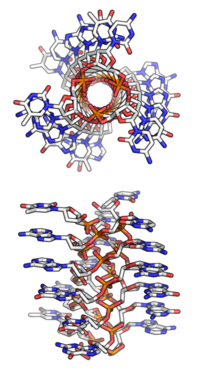Obsolete models of DNA structure
[1] These were also rejected due to accumulating experimental evidence from X-ray crystallography, solution NMR, and atomic force microscopy (of both DNA alone, and bound to DNA-binding proteins).
Although localised or transient non-duplex helical structures exist,[2] non-helical models are not currently accepted by the mainstream scientific community.
[3] Finally, there exists a persistent set of contemporary fringe theories proposing a range of unsupported models.The DNA double helix was discovered in 1953[4] (with further details in 1954[5]) based on X-ray diffraction images of DNA (most notably photo 51, taken by Raymond Gosling and Rosalind Franklin[6]) as well as base-pairing chemical and biochemical information.
The most famous of these early models was by Linus Pauling and Robert Corey in 1953 in which they proposed a triple helix with the phosphate backbone on the inside, and the nucleotide bases pointing outwards.
[24] The discovery of topoisomerases and gyrases, enzymes that can change the linking number of circular nucleic acids and thus "unwind" and "rewind" the replicating bacterial chromosome, solved the topological objections to the B-form DNA helical structure.
[25] Indeed, in the absence of these topology-altering enzymes, small circular viral and plasmid DNA are inseparable supporting structure whose strands are topologically locked together.
